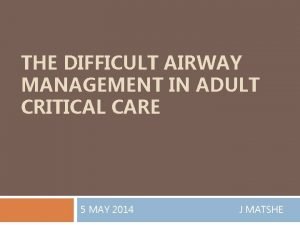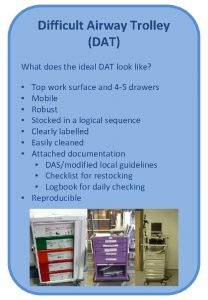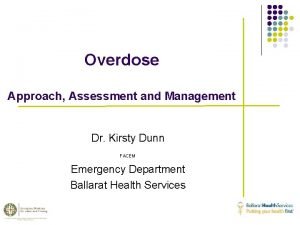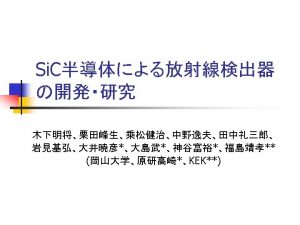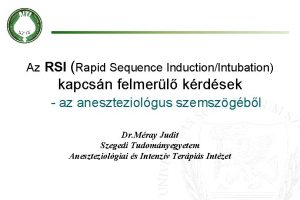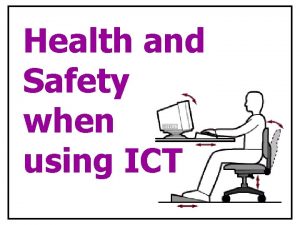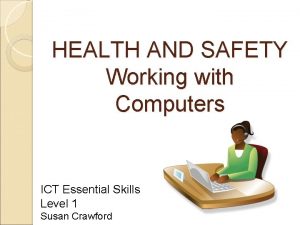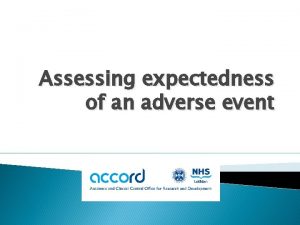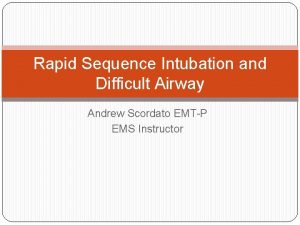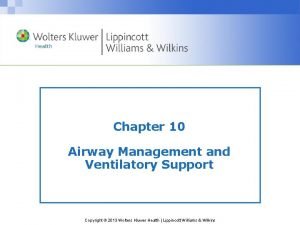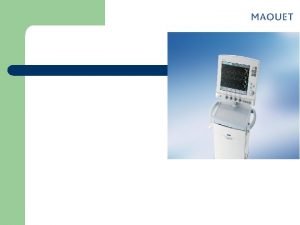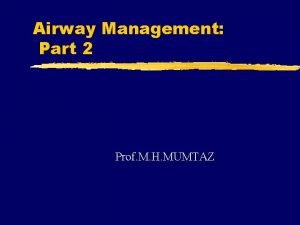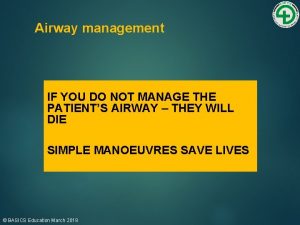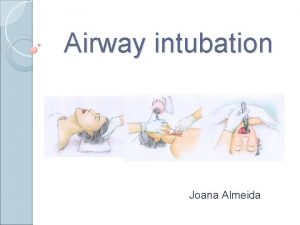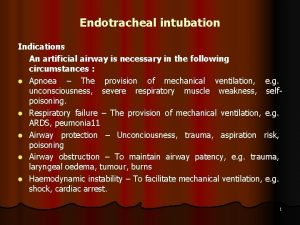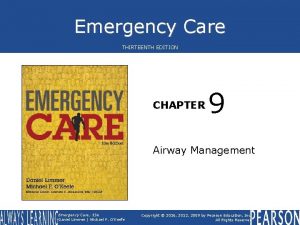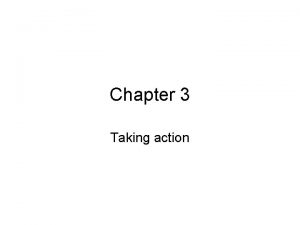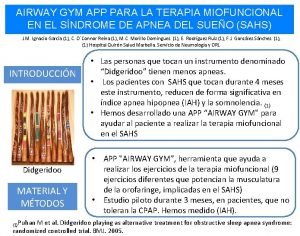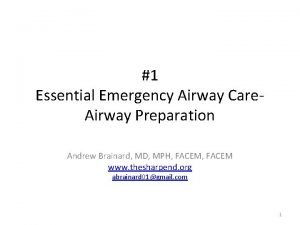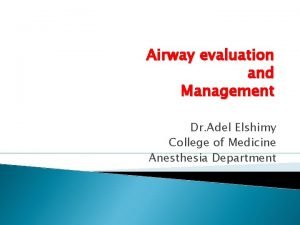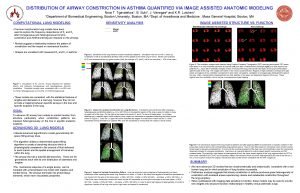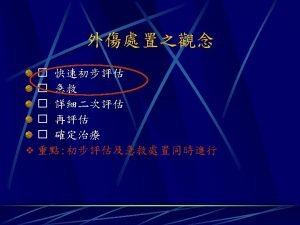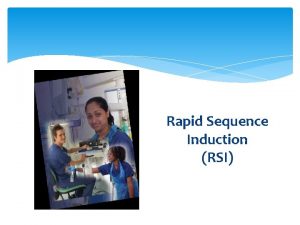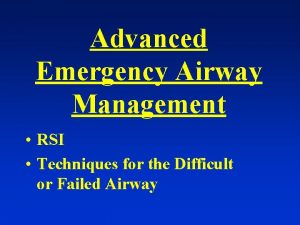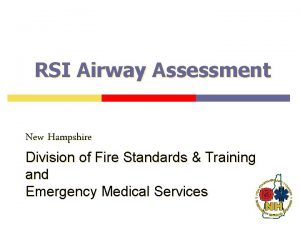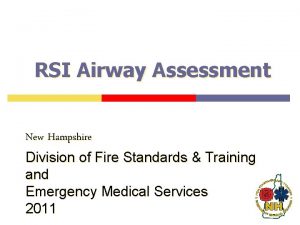RSI Difficult airway CICV SAMI Online Tutorial Anticipation







































































- Slides: 71

RSI Difficult airway CICV SAMI On-line Tutorial Anticipation

Anticipation • This on-line material covers theory needed to manage the airway on ICU. CICV • In March 2011 the 4 th National Audit program (which can be found here) found that a disproportionate number of reported airway events occurred on Intensive Care Units (ICUs). The reasons it highlighted for this included a lack of; skilled staff, planning, appropriate equipment and appropriate responses to unfolding events. 58% of events were felt to have been caused, or contributed to, by education and training. Difficult airway • The purpose of this course is to improve the skills of the team involved in managing the airway of intensive care patients. RSI Introduction

• As everyone has a different background, some people may be very familiar with this material, whereas for others it may be revision or even novel. Anticipation • Its up to you to decide which of the sections you need to visit! CICV • Although some of the material covered here will be revisited on the day there will be no lectures. To make the most of the day please make sure you are happy with the learning outcomes from each section. Difficult airway • The on-line material is divided into 4 sections. At the beginning of each section there is a summary of what it will cover and the learning outcomes. RSI Introduction

RSI Navigation clicking on Anticipation • In some places there are information buttons these will provide you with further information. CICV • There is also a navigation bar at the right side of each page. The beginning of each section can be accessed by clicking on the corresponding button, and clicking on the home button at the bottom will take you back to the contents page. Difficult airway • There is a navigation button at the bottom right hand corner of each page. , or. Click on this once you have finished each page.

CICV Difficult airway Rapid sequence induction (RSI) RSI Contents Can’t intubate, can’t ventilate (CICV) Anticipation Anticipating a difficult airway

RSI Difficult airway CICV Rapid Sequence Induction On-line Tutorial Anticipation

Anticipation • The B@EASE algorithm • The equipment used • The drugs involved CICV Learning Outcomes • Understand what a RSI is • Understand why a RSI is commonly used in ICU patients • Know what is involved in performing a RSI including Difficult airway This section covers how to perform a rapid sequence induction (RSI). RSI Summary

What is RSI? Why do we do it? What do we do? Risks Difficult airway • • RSI Contents CICV Anticipation

Anticipation It involves • Loss of consciousness during cricoid pressure • Intubation without mask ventilation CICV The aim is to • Intubate trachea as quickly and safely as possible • Reduce the risk of aspiration Difficult airway Rapid sequence induction is an established method of inducing anaesthesia. RSI What is RSI?

ICU patients are particularly at risk of aspiration due to CICV • Insufficient time to wait between patients last meal/NG feed and intubation • Delayed gastric emptying (due to drugs, pain, ileus etc. ) • Decreased GCS and impaired airway reflexes • Bowel pathology Difficult airway RSI aims to minimise the risk of aspiration and is very frequently used for ICU intubations. RSI Why do we do it? Anticipation

Difficult airway An RSI can be divided into three stages 1. Preparation 2. Procedure 3. Confirmation of tube placement RSI What do we do? CICV Anticipation

Preparation Difficult airway The next slides show the B@EASE check list. Going through this ensures that the team is ready to perform the RSI What do we do? CICV Anticipation

RSI What do we do? Difficult airway CICV Anticipation

Preparation Remember TEAM INTRODUCTIONS Difficult airway Quick Team Brief at decision to RSI A minimum of 3 people are required RSI What do we do? CICV Anticipation

Preparation Difficult airway This lists the equipment required to perform an RSI. Use the checklist as an aide-memoire. RSI What do we do? CICV Anticipation

Preparation Difficult airway Use the checklist as an aide-memoire to organise the equipment, position the patient and check the drugs are drawn up and ready to go RSI What do we do? CICV Anticipation

Preparation Difficult airway Ensure everyone is aware of their role during the procedure RSI What do we do? CICV Anticipation

Preparation Difficult airway We will cover this in more detail in the sections on difficult airways and can’t intubate, can’t ventilate. RSI What do we do? CICV Anticipation

Preparation Each box requires an answer, either “Yes/No” or a brief comment CICV Anticipation For example: Q - “ 2 working Laryngoscopes” A - “Yes” Q - “Manual In-line Stabilisation Required” A - “Not required” Q - “Verbalise Drug Doses and Volumes” A - “___mg/Kg Induction agent =___mg = ___mls ” Q - “Intubator (1 st/2 nd)” A - “Dr X / Dr Y” Difficult airway When everything is ready, and whilst the patient is being pre-oxygenated, the Team Leader reads the whole checklist out just prior to drug administration RSI What do we do?

Procedure Difficult airway CICV Once everyone and everything is ready the RSI is performed as follows 1. The patient is pre oxygenated 2. Cricoid pressure is applied 3. An iv induction agent(s) is/are given 4. Followed rapidly by a muscle relaxant 5. The patient is intubated 6. Tube placement is confirmed RSI What do we do? Anticipation

Anticipation The decision as to whether further anaesthesia and/or paralysis is administered is challenging CICV Also be aware that the drugs may wear off if intubation is difficult. This may be beneficial as the patient may resume spontaneous ventilation, or may be detrimental resulting in awareness of airway instrumentation and increased difficulty in intubation. Difficult airway The main risk with a RSI is that we do not know we can ventilate the patient before paralysing them. It is therefore essential that • The airway is assessed • There is a plan for a difficult/failed intubation RSI Risks

Difficult airway The B@EASE checklist is widely used in ICUs across the Greater Manchester region. However the Difficult Airway Society (DAS) recently released its own check list. The principles of the DAS checklist are very similar to B@EASE and it may be used in some units you work in. What is important is that a check list is used. RSI Note CICV Anticipation

Difficult airway You should now know what a RSI is and how it is performed RSI Conclusion CICV Anticipation

RSI Preoxygenation This is to allow as much time as possible to perform the intubation before the patient becomes hypoxic • Use a tight-fitting mask • High flow oxygen • For 3 minutes (ETO 2 should be >90%) if possible, or 5 vital capacity breaths is an alternative if limited time available Difficult airway Note: if any air is entrained the preoxygenation should be started again CICV Anticipation

• It should be performed by a trained assistant. • Pressure is applied Image credit: http: //airwayeducation. homestead. com/airway 4. jpg Anticipation • Cricoid pressure is only released when asked to by the person performing the intubation. CICV to the cricoid cartilage of 10 N initially, increased to 30 N once the patient is unconscious Difficult airway • The aim of cricoid pressure is to occlude the oesophagus and hence reduce the risk of regurgitation and aspiration RSI Cricoid Pressure

An opiate may be given either before or after the intubation to help obtund the hypertensive response to laryngoscopy Difficult airway • An induction agent is used to provide general anaesthesia • Classically thiopentone is used • However you will often see other agents used instead including propofol, ketamine and less frequently etomidate RSI Induction Agents CICV Anticipation (More information on each of the drugs can be found by clicking on them. This is only required if you are responsible for administering them. )

Difficult airway CICV • Dose: 4 -6 mg/kg iv • Effect: Hypnotic • Advantages: Rapid predictable onset (one arm-brain circulation time) • Disadvantages: Hypotension, allergy, intra-arterial injection causes tissue necrosis, can trigger porphyria crises • Other: has to be reconstituted in water prior to use RSI Thiopentone Anticipation

Difficult airway Dose: 1. 5 -2. 5 mg/kg Effect: Hypnotic Advantages: suppresses laryngeal reflexes, anti-emetic Disadvantages: Slower onset than thiopentone (and slower offset), CVS instability (vasodilatation and cardiac suppression) • Other: Can cause epileptiform movements • • RSI Propofol CICV Anticipation

Difficult airway • A muscle relaxant is given to paralyse the patient • Classically suxamethonium is given • However rocuronium is also now commonly used RSI Muscle Relaxants CICV Anticipation (More information on each of the drugs can be found by clicking on them. This is only required if you are responsible for prescribing them. )

Dose: 1. 0 – 2. 0 mg/kg iv Effect: Profound neuromuscular blockade Advantages: Rapid onset (within 60 secs) and offset (3 -5 mins) Disadvantages: Lots of side effects including Anticipation • Other: Patient fasciculates before relaxing CICV • Hyperkalaemia • Bradycardia • Suxamethonium apnoea (i. e. prolonged effect ranging from 30 mins to several hours) • Raised intraocular and intracranial pressure (transient) • Malignant hyperthermia • Allergy Difficult airway • • RSI Suxamethonium

Difficult airway CICV • Dose: 0. 6 – 1. 2 mg/kg • Effect: neuromuscular blockade (non-depolarizing) • Advantages: Can be rapidly reversed with sugammadex, does not cause significant cardiovascular instability or electrolyte disturbances • Disadvantages: Longer onset than sux (60 seconds) and offset (dependant on dose administered) • Other: Prolonged effect in renal faliure RSI Rocuronium Anticipation

Anticipation • Once the placement of the tube is confirmed it should be secured in position and a check x ray taken CICV • It is important to then check that the tube is in the correct position and has not gone down into the right or left main bronchus (most commonly the right main bronchus). This is done by auscultating on both sides of the chest and checking the length of the tube at the teeth (roughly 19 -21 cm for women, 21 -23 cm for men) Difficult airway • This is done by a combination of watching the tube pass through the vocal cords, observing the chest rising and falling and most importantly with a sustained capnography trace. RSI Confirming tube placement

RSI Difficult airway CICV Difficult airway On-line Tutorial Anticipation

CICV Learning Outcomes • Know how to prepare for a potentially difficult airway • Have reviewed and understood the difficult airway algorithms Difficult airway This section covers how to manage a difficult airway. RSI Summary Anticipation

Definition Airway management in ICU patients How to prepare for the difficult airway Use of the Difficult Airway Society algorithms Suggested equipment Difficult airway • • • RSI Contents CICV Anticipation

• Difficulty with LMA insertion CICV Consider EVERY intubation on ICU to be difficult until proven otherwise! Difficult airway • A clinical situation in which a conventionally trained anaesthetist experiences difficulty with mask ventilation, tracheal intubation (using Macintosh blade), or both RSI Definition Anticipation

• Multifactorial CICV Anticipation • More sick patients; less time to prepare correctly, less time to employ secondary strategies, more stress on team. • Distorted anatomy; airway oedema more common, previously intubated, surgery to airway, tracheostomy. • Less frequent event compared to theatre • Staff less familiar with difficult airway equipment • Patients not optimally positioned, trolleys vs beds Difficult airway • In March 2011 the 4 th National Audit program found that a disproportionate number of reported airway events occurred on ICUs • Why? RSI Airway management in ICU patients

Difficult airway CICV • Induction of anaesthesia and intubation of a critically ill patient is challenging • A checklist should be used prior to any airway procedure on the ICU (see section on RSI) • The Emergency Plan should be discussed within the team before commencing induction of anaesthesia • The decision regarding whether the patient should be allowed to wake up in the event of a failed intubation should be discussed before starting. RSI Preparing for a difficult intubation Anticipation

Difficult airway CICV • The Emergency Plan requires consideration of what to do if the first plan fails, i. e a plan B, C and D • The Difficult Airway Society have an algorithm which helps guide the team in the event of a failed intubation • Difficult Airway Trolleys should be divided into Plan A, Plan B, Plan C and Plan D, with each ‘plan’ occupying a drawer in the trolley. The equipment required for each plan should be kept within the drawer RSI Preparing for a difficult intubation Anticipation

CICV • The DAS guidelines are extremely useful when constructing the Plans A-D for the intubation of a critically ill patient Difficult airway • The next slide show the DAS flowchart for intubation in critical ill patients • This is subsequently explained in detail RSI Preparing for a difficult Algorithms intubation Anticipation

RSI Difficult airway CICV Anticipation • The DAS algorithm for intubation of critically ill adults is shown here • Plans A and B are concerned with securing the airway, but failure to oxygenate means you should move to Plan C • Plan C suggests waking the patient if you are able to oxygenate, however this may not be an option for a critically ill patient • Plan D involves rescue strategies in the event of a can’t intubate, can’t ventilate situation

Plan A RSI Difficult airway • Direct laryngoscopy • No more than 3 attempts at intubation should be made • If after 3 attempts intubation has failed – move to plan B/C CICV Anticipation

Plan B/C RSI Difficult airway • The aim is to oxygenate the patient • If it is not safe to wake the patient then oxygenation should be maintained by face mask or LMA until a definitive airway is inserted. This is likely to require input from a more senior colleague • If you are unable to oxygenate – move to plan D CICV Anticipation

RSI Plan D • See section on can’t intubate can’t ventilate situations Difficult airway CICV Anticipation

Difficult airway The team should decide whether it is appropriate to wake the patient before commencing the RSI Preparing for a Difficult Intubation CICV Anticipation

Difficult airway • Knowledge of both the content and layout of the difficult airway trolley is paramount • An example stock list for a difficult airway trolley can be found here RSI Preparing for a Difficult Equipment Intubation CICV Anticipation

Difficult airway You should now • Understand what a difficult airway situation is • Know how to use the difficult airway society algorithms • Be aware of the layout of a standard difficult airway trolley RSI Conclusion CICV Anticipation

RSI Preparing for a Difficult Equipment Intubation Difficult airway CICV Anticipation

RSI Difficult airway CICV Can’t intubate, Can’t ventilate On-line Tutorial Anticipation

CICV Learning Outcomes • Know what a can’t intubate, can’t ventilate situation is • Know what is involved in the can’t intubate, can’t ventilate algorithm Difficult airway This section covers what happens when, following induction, you cannot intubate or ventilate the patient. RSI Summary Anticipation

Difficult airway • Definition • Management RSI Contents CICV Anticipation

CICV Without oxygen delivery by some means the patient will rapidly become hypoxic and often the option of allowing the patient to wake and spontaneously breathe may not be available in the critically ill ICU patient Difficult airway Having performed a RSI you are unable to intubate the patient. If your rescue strategies also fail to oxygenate the patient then you have a can’t intubate, can’t ventilate scenario RSI Definition Anticipation

CICV The next side shows the Difficult Airway Society (DAS) guidelines for the management of a can’t intubate, can’t ventilate situation – Plan D. Difficult airway In the event of a can’t intubate, cant ventilate situation a “front of neck airway” FONA is performed RSI Management Anticipation

RSI Difficult airway CICV Anticipation

It is now recommended by DAS that a scalpel cricothyroidotomy is performed. CICV A demonstration of the scalpel cricothyroidotomy technique can be seen at the following link https: //www. youtube. com/watch? v=Du. LPCAM 6 Zh. A Difficult airway The important point in a can’t intubate situation is not to delay. If plans A, B and C have failed you must move onto plan D. RSI Management Anticipation

Difficult airway You should now know what a can’t intubate, can’t ventilate situation is and how it should be managed according to the DAS guidelines RSI Conclusion CICV Anticipation

RSI Difficult airway CICV Anticipating a difficult airway On-line Tutorial Anticipation

CICV Learning Outcomes • Know important aspects of history, examination and investigation which may help predict a difficult airway • Know different techniques for assessing a patients airway • Understand the limitations in airway assessment Difficult airway This section covers how to assess a patients airway and anticipate difficulties before they arise RSI Summary Anticipation

How to assess the airway History Examination Investigation Is assessment any good? Difficult airway • • • RSI Contents CICV Anticipation

Knowing this may alter your plans for intubation CICV When reviewing a patient to assess their airway it is important to take a detailed history, perform an appropriate examination and review any relevant investigations they have had. Difficult airway It is sometimes possible to anticipate that a patient may be difficult to intubate. RSI How to assess the airway Anticipation

Symptoms • Voice change • Dysphagia • Positional effect on breathing • Stridor Difficult airway The following may alert you to a possible problem with the airway RSI History Medical history • Alert bracelet, letter • Patient notes - anaesthetic charts Anticipation Other sources of information CICV • Congenital • eg Pierre Robin • Acquired • Neoplastic: tumour, surgery, radiotherapy • Infection: dental abscess • Endocrine: thyroid goitre, acromegaly, diabetes • Trauma: laryngeal, neck • Inflammatory/ connective tissue: Rheumatoid arthritis, ankylosing spondylitis • Previous difficult airway

CICV Anticipation All of these may make intubation more difficult Difficult airway Does the patient have • Buck teeth • Missing teeth • Receding jaw • Small mouth • Large tongue • Bull neck • Obesity • Beard RSI Examination

CICV Anticipation Performing more than one of the tests can reduce the number of false positives and false negatives Difficult airway There are more specific examinations which can be performed to help identify a patient with a difficult airway. These include • Mallampati Test • Thyromental Distance (Patil) • Mandibular Subluxation (Calder) • Inter Incisor Gap • Other tests RSI Examination

RSI Investigations Difficult airway • These tests can be helpful identifying patients with abnormal anatomy who are likely to be difficult, but do not guarantee an easy intubation Anticipation CICV A patient may have had relevant investigations. These could either be for their present condition or done in the past for some other reason. If available they should be reviewed and may alert you to a possible problem. For example • Plain X-ray of the neck • Scans including CT or MRI of the neck • Nasendoscopy

CICV Anticipation And if it’s a false alarm? Its not a problem, the patient will still have been safely intubated Difficult airway There will always be false positives and false negatives when assessing the airway and there is significant inter-observer variability. A positive test however does increase the chance of difficulty. Although difficult airways will be missed, each one that is correctly identified reduces the risk. • It allows the choice of the safest technique to be made in advance. • It may affect where and by whom the procedure is performed. • The correct back up strategy can be in place (this may include an anesthetic consultant or a ENT surgeon to be present) RSI Is assessment any good?

CICV In a critical care setting a detailed assessment of the patient’s airway may not be possible. The patient may have a reduced level of consciousness and therefore not cooperate with examination and the time frame for intubation is more time critical. Difficult airway You should now know how you can assess a patient’s airway to attempt to anticipate those that may be difficult RSI Conclusion Anticipation

CICV Size of tongue in relation to oral cavity Face to face Open as wide as possible Stick tongue out Dont say “Aah” 3, 4 = difficulty Difficult airway • • • RSI Mallampati Test Anticipation

Head back as far possible Mouth closed Less than 6. 5 cm = difficulty 4 fingers Difficult airway • • RSI Thyromental Distance (Patil) CICV Anticipation

• Class A = bottom teeth in front of top teeth • Class B = teeth level • Class C = bottom teeth behind top teeth Difficult airway • Push bottom teeth out in front of top teeth RSI Mandibular Subluxation (Calder) B, C = difficulty CICV Anticipation

Difficult airway • Normal = 5 cm = 3 fingers • <3 cm = difficult laryngoscopy • <2 cm = difficult LMA insertion RSI Inter Incisor Gap CICV Anticipation

Difficult airway • Sternomental distance (Savva) >12. 5 cm • Ratio of height to Thyromental distance >23. 5 cm • Delikan’s test (neck movement) RSI Other tests • Wilson’s score (scoring system of 5 variables) CICV Anticipation
 Upper airway and lower airway
Upper airway and lower airway Thyromental distance
Thyromental distance Ideal dat
Ideal dat Asa difficult airway algorithm
Asa difficult airway algorithm Difficult airway ppt
Difficult airway ppt Responsive anticipation and creative anticipation
Responsive anticipation and creative anticipation Responsive anticipation and creative anticipation
Responsive anticipation and creative anticipation Resus rsi dead
Resus rsi dead Rsi medication order
Rsi medication order Hsi rsi
Hsi rsi Kombitubus
Kombitubus Rsi security camera
Rsi security camera Rsi vs dsi
Rsi vs dsi Dr sarno methode
Dr sarno methode The sam initiative
The sam initiative Rsi
Rsi Ctfg rsi
Ctfg rsi Ict legal issues
Ict legal issues Rsi ravenna
Rsi ravenna Health and safety in ict
Health and safety in ict Ctfg rsi
Ctfg rsi Idp sensor
Idp sensor Ict health and safety
Ict health and safety Expectedness
Expectedness Structure of the upper respiratory system
Structure of the upper respiratory system Tatalaksana acls
Tatalaksana acls Pathway of air in respiratory system
Pathway of air in respiratory system Respiratory airway secretary
Respiratory airway secretary Intubation anatomy
Intubation anatomy Laryngoscopy view grades
Laryngoscopy view grades Log roll
Log roll Optimal peep
Optimal peep Nasal trumpet measurement
Nasal trumpet measurement Mean airway pressure
Mean airway pressure Endotrakeal tüp numaraları
Endotrakeal tüp numaraları Sniffing position
Sniffing position Chandys maneuver
Chandys maneuver Pharyngo-tracheal lumen airway
Pharyngo-tracheal lumen airway Chapter 10 airway management
Chapter 10 airway management Mean airway pressure formula
Mean airway pressure formula Ahi cpap
Ahi cpap Push hard push fast fully recoil
Push hard push fast fully recoil Airway numaraları
Airway numaraları Asa classification
Asa classification Aprv waveform
Aprv waveform Intubating lma
Intubating lma Pharyngo-tracheal lumen airway
Pharyngo-tracheal lumen airway Head tilt chin lift jaw thrust
Head tilt chin lift jaw thrust Airway ladder
Airway ladder Sniffing position for intubation
Sniffing position for intubation Actual diagnosis
Actual diagnosis Indications for artificial airway
Indications for artificial airway Npa measurement
Npa measurement The emergency action steps are
The emergency action steps are Airway gym app
Airway gym app Technique abcde
Technique abcde Airway breathing c
Airway breathing c Norwich terrier upper airway syndrome
Norwich terrier upper airway syndrome Moans airway
Moans airway Asa airway
Asa airway Generations of supraglottic airway devices
Generations of supraglottic airway devices Nasopharyngeal airway
Nasopharyngeal airway Nasopharyngeal airway
Nasopharyngeal airway Hypoventilasi
Hypoventilasi Bronchioles
Bronchioles Mouth gag airway
Mouth gag airway Stepwise airway management
Stepwise airway management Open a casualty's airway
Open a casualty's airway Ehbo abcde
Ehbo abcde Thyromental distance of 7cm
Thyromental distance of 7cm Constricted airway
Constricted airway Definitive airway
Definitive airway

